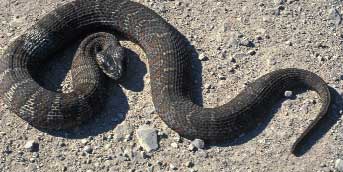
and a Forked Tongue that Speaks True
By Dan Zarlenga, Missouri Department of Conservation
Photo Caption: No, it’s not a copperhead . . . it’s a nonvenomous northern watersnake! Photo by Jim Rathert, Missouri Department of Conservation.
The term “speaking with a forked tongue” usually refers to someone who tells lies. Yet for a reptile like the northern watersnake, it is precisely a forked tongue that reveals the truth about its surroundings.
The northern watersnake is a common resident throughout Missouri. As one might imagine by its name, this snake is often found near water: wet places like creeks, rivers, sloughs, ponds, lakes, and swamps. You might see one secluded under rocks or other objects on the water’s edge, or perhaps even on a gravel road that runs to a lake or river access. As people head out to rivers and streams for summertime floating, an encounter with a northern watersnake is certainly possible.
Northern watersnakes are gray to reddish-brown with a number of dark brown, reddish-brown, or blackish crossbands along the front third of the body. The bands morph into blotches in the latter part of the body. The belly is cream-colored or yellowish and decorated with black and reddish half-moon markings or spots. These snakes are about two feet to 50 inches long.
People often mistake northern watersnake markings for the Hershey kiss- or teardrop-shaped patterns of the venomous copperhead. Unfortunately, this can result in the death of the northern watersnake due to miss-association. Maybe resembling a venomous snake carries some protection in the wild, but not so much when humans figure into the equation.
Now, it is true that northern watersnakes will bite if threatened, and can be very aggressive when doing so, though their chomps are merely blanks that carry no venom. They do however emit a nasty smelling musk from a gland at the end of their tail that is sure to discourage further interactions. Of course, the best way to avoid conflict is always to avoid contact!
The northern watersnake is a predator of some fish, frogs, tadpoles, toads, and salamanders. There are those who believe that these snakes compete with anglers by eating popular gamefish, but that rumor was surely started by someone speaking with forked tongue. Most gamefish can easily out swim the snakes and get away—except for diseased fish which an angler would not want anyway.
Speaking of that forked tongue, northern watersnakes, like all snake species, make good use of it to learn the truth of what’s around them. Each fork has its own set of chemical sensors that enable the snake to smell stereophonically, the same way our two eyes or a pair of ears enables us to see and hear in stereo.
Since each tip of the tongue picks up odors slightly offset from the other, the snake can detect the direction of the source by identifying which side registers the odor the most. The chemical particles are passed from the tongue to a unique sensory organ in the snake’s head behind the nose called the omeronasal, or Jacobson’s, organ. Decoded through the omeronasal organ and processed through the snake’s reptilian brain, this information paints a 3-D picture of the environment in smell.
So, you might say that when a snake like the northern watersnake wants to learn more about what’s around them, the answer is literally on the tip of its tongue.


